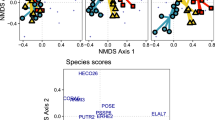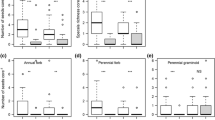Abstract
Fires in mountain big sagebrush [Artemisia tridentata spp. vaseyana (Rydb.) Beetle] plant communities historically shifted dominance from woody to herbaceous vegetation. However, fire return intervals have lengthened with European settlement, and sagebrush dominance has increased at the expense of herbaceous vegetation in some plant communities. Management actions may be needed to decrease sagebrush in dense sagebrush stands to increase herbaceous vegetation. Prescribed fire is often used to remove sagebrush; however, mechanical treatments, such as mowing, are increasingly used because they are more controllable and do not pose an inherent risk of escape compared with fire. However, information on the effects of burned and mowed treatments on herbaceous vegetation and whether fire and mowed applications elicit similar vegetation responses are limited. We evaluated the effects of prescribed burning and mowing for 3 years after treatment in mountain big sagebrush plant communities. The burned and mowed treatments generally increased herbaceous cover, density, and production compared with untreated controls (P < 0.05). However, neither treatment induced a response in native perennial forb cover, density, or biomass (P > 0.05). In contrast, annual forb (predominately natives) cover, density, and biomass increased with mowing and burning (P < 0.05). Vegetation generally responded similarly in burned and mowed treatments; however, the burned treatment had less sagebrush, greater herbaceous vegetation production, and more bare ground than the mowed treatment (P < 0.05). These differences should be considered when selecting treatments to decrease sagebrush.



Similar content being viewed by others
References
Ackerman TL (1979) Germination and survival of perennial plant species in the Mojave Desert. Southwest Nat 24:399–408
Bates JD, Svejcar TJ (2009) Herbaceous succession after burning cut western juniper trees. West North American Nat 69:9–25
Bates JD, Miller RF, Svejcar T (2005) Long-term successional trends following western juniper control. Rangel Ecol Manag 58:533–541
Bates JD, Davies KW, Sharp RN (2011) Shrub-steppe early succession following juniper cutting and prescribed fire. Environ Manag 47:468–481
Beck JL, Mitchell DL (2000) Influence of livestock grazing on sage grouse habitat. Wildl Soc Bull 28:993–1002
Beck JL, Connelly JW, Reese KP (2009) Recovery of greater sage-grouse habitat features in Wyoming big sagebrush following prescribed fire. Restor Ecol 17:393–403
Blaisdell JP (1953) Ecological effects of planned burning of sagebrush-grass range on the upper Snake River Plains. USDA Technical Bulletin No. 1075, Washington, DC
Boyd CS, Davies KW (2010) Shrub microsite influences post-fire perennial grass establishment. Rangel Ecol Manag 63:248–252
Boyd CS, Svejcar TJ (2011) The influence of plant removal on succession in Wyoming big sagebrush. J Arid Environ 75:734–741
Canfield RH (1941) Application of the line interception methods in sampling range vegetation. J For 39:388–394
Chambers JC, Roundy BA, Blank RR, Meyer SE, Whittaker A (2007) What makes Great Basin sagebrush ecosystems invasible by Bromus tectorum? Ecol Monogr 77:117–145
Collins BM, Stephens SL, Moghaddas JJ, Battles J (2010) Challenges and approaches in planning fuel treatments across fire-excluded forested landscapes. J For 108:24–31
Connelly JW, Schroeder MA, Sands AR, Braun CE (2000) Guidelines to manage sage grouse populations and their habitats. Wildl Soc Bull 28:967–985
Conrad EC, Poulton CE (1966) Effect of wildfire on Idaho fescue and Bluebunch wheatgrass. J Range Manag 19:138–141
Crawford JA, Olson RA, West NE, Mosley JC, Schroeder MA, Whitson TD et al (2004) Ecology and management of sage-grouse and sage-grouse habitat. J Range Manag 57:2–19
Dahlgren DK, Chi R, Messmer TA (2006) Greater sage-grouse response to sagebrush management in Utah. Wildl Soc Bull 34:975–985
Davies KW (2008) Medusahead dispersal and establishment in sagebrush steppe plant communities. Rangel Ecol Manag 61:110–115
Davies KW, Bates JD (2010a) Vegetation characteristics of mountain and Wyoming big sagebrush plant communities in the northern Great Basin. Rangel Ecol Manag 63:461–466
Davies KW, Bates JD (2010b) Native perennial forb variation between mountain big sagebrush and Wyoming big sagebrush plant communities. Environ Manage 46:452–458
Davies KW, Bates JD, Miller RF (2007) Short-term effects of burning Wyoming big sagebrush steppe in southeast Oregon. Rangel Ecol Manag 60:515–522
Davies KW, Bates JD, James JJ (2009a) Microsite and herbaceous vegetation heterogeneity after burning Artemisia tridentata steppe. Oecologia 159:597–606
Davies KW, Svejcar TJ, Bates JD (2009b) Interaction of historical and non-historical disturbances maintains native plant communities. Ecol Appl 19:1536–1545
Davies KW, Bates JD, Nafus AM (2011) Are there benefits to mowing intact Wyoming big sagebrush communities? An evaluation from southeastern Oregon. Environ Manag 48:539–546
Davies KW, Bates JD, Nafus AM (2012) Vegetation response to mowing dense mountain big sagebrush stands. Rangel Ecol Manag 65:268–276
Eastern Oregon Agricultural Research Center (2010) EOARC weather data. EOARC, Burns
Goergen EM, Chamber JC (2009) Influence of a native legume on soil N and plant response following prescribed fire in sagebrush steppe. Int J Wildl Fire 18:665–675
Harniss RO, Murray RB (1973) 30 years of vegetal change following burning of sagebrush-grass range. J Rangel Manag 26:322–325
Hedrick DW, Hyder DN, Sneva FA, Poulton CE (1966) Ecological response of sagebrush-grass range in central Oregon to mechanical and chemical removal of Artemisia. Ecology 47:432–439
Hess JE, Beck JL (2012) Burning and mowing Wyoming big sagebrush: do treated sites meet minimum guidelines for greater sage-grouse breeding habitats? Wildl Soc Bull 36:85–93
Holmes AL (2007) Short-term effects of a prescribed burn on songbirds and vegetation in mountain big sagebrush. West North American Nat 67:292–298
James JJ, Davies KW, Sheley RL, Aanderud ZT (2008) Linking nitrogen partitioning and species abundance to invasion resistance in the Great Basin. Oecologia 156:637–648
Johnson JR, Payne GF (1968) Sagebrush re-invasion as affected by some environmental influences. J Rangel Manag 21:209–212
Johnson CW, Schumaker GA, Smith JP (1980) Effects of grazing and sagebrush control on potential erosion. J Rangel Manag 33:451–454
Kigel J (1995) Seed germination in arid and semiarid regions. In: Kigel J, Galili G (eds) Seed development and germination. Marcel Dekker, New York, NY, pp 654–699
Littell RC, Milliken GA, Stroup WW, Wolfinger RD (1996) SAS system for mixed models. SAS Institute, Cary, NC
Maier AM, Perryman BL, Olson RA, Hild AL (2001) Climatic influences on recruitment of three subspecies of Artemisia tridentata. J Rangel Manag 54:699–703
McDaniel KC, Anderson DL, Ballientte JF (1991) Wyoming big sagebrush control with metsulfuron and 2, 4-D in northern New Mexico. J Rangel Manag 44:623–627
Miller RF, Heyerdahl EK (2008) Fine-scale variation of historical fire regimes in sagebrush-steppe and juniper woodland: an example from California, USA. Int J Wildl Fire 17:245–254
Miller RF, Rose JA (1999) Fire history and western juniper encroachment in sagebrush steppe. J Rangel Manag 52:550–559
Mueggler WF (1956) Is sagebrush seed residual in the soil of burns or is it wind-borne? USDA Forest Service, Intermountain Forest and Range Experiment Station Research Note, RN INT-35. Ogden, UT
Mueggler WF, Blaisdell JP (1958) Effects on associated species of burning, rotobeating, spraying, and railing sagebrush. J Rangel Manag 11:61–66
Nelle PJ, Reese KP, Connelly JW (2000) Long-term effects of fire on sage grouse habitat. J Rangel Manag 53:586–591
Noson AC, Schmitz RA, Miller RF (2006) Influence of fire and juniper encroachment on birds in high-elevation sagebrush steppe. West North American Nat 66:343–353
Natural Resource Conservation Service (1998) Climate dataset. NRCS, Fort Worth, TX
Olson RA, Whitson TD (2002) Restoring structure in late-successional sagebrush communities by thinning with tebuthiuron. Restor Ecol 10:146–155
Peek JM, Riggs RA, Lauer JL (1979) Evaluation of fall burning on bighorn sheep winter range. J Rangel Manag 32:430–432
Pierson FB, Robichaud PR, Moffet CA, Spaeth KE, Hardegree SP, Clark PE et al (2008) Fire effects on rangeland hydrology and erosion in a steep sagebrush-dominated landscape. Hydrol Process 22:2916–2929
Pierson FB, Moffet CA, Williams CJ, Hardegree SP, Clark P (2009) Prescribed-fire effects on rill and interrill runoff and erosion in a mountainous sagebrush landscape. Earth Surf Proc Land 34:193–203
Pyle WH, Crawford JA (1996) Availability of foods of sage grouse chicks following prescribed fire in sagebrush–bitterbrush. J Rangel Manag 49:320–324
Reinkensmeyer DP, Miller RF, Anthony RG, Marr VE (2007) Avian community structure along a mountain big sagebrush gradient. J Wildl Manag 71:1057–1066
Rhodes EC, Bates JD, Sharp RN, Davies KW (2010) Fire effects on cover and dietary resources of sage-grouse habitat. J Wildl Manag 74:755–764
Rittenhouse LR, Sneva FA (1976) Expressing the competitive relationship between Wyoming big sagebrush and crested wheatgrass. J Rangel Manag 29:326–327
Sneva FA (1972) Grazing return following sagebrush control in eastern Oregon. J Rangel Manag 25:174–178
Stewart G, Hull AC (1949) Cheatgrass (Bromus tectorum L.)—An ecologic intruder in southern Idaho. Ecology 30:58–74
Uresk DW, Cline JF, Packard WH (1976) Impact of wildfire on three perennial grasses in south-central Washington. J Rangel Manag 29:309–310
Uresk DW, Packard WH, Cline JF (1980) Perennial grasses and their response to a wildfire in south-central Washington. J Rangel Manag 33:111–114
Urness PJ (1979) Wildlife habitat manipulation in sagebrush ecosystems. In: The sagebrush ecosystem: A symposium. April 1978. College of Natural Resources, Utah State University, Logan, UT, pp 169–178
Vale TR (1974) Sagebrush conversion projects: an element of contemporary environmental change in the western United States. Biol Conserv 6:274–284
Wambolt CL, Payne GF (1986) An 18-year comparison of control methods for Wyoming big sagebrush in southwestern Montana. J Rangel Manag 39:314–319
Wambolt CL, Walhof KS, Frisina MR (2001) Recovery of big sagebrush communities after burning in south-western Montana. J Environ Manag 61:243–252
West NE (1983) Great Basin-Colorado Plateau sagebrush semi-desert and western Intermountain sagebrush steppe. In: West NE (ed) Ecosystems of the world: temperate deserts and semi-deserts. Elsevier, Amsterdam, pp 331–374
West NE, Hassan MA (1985) Recovery of sagebrush-grass vegetation following wildfire. J Rangel Manag 38:131–134
Wirth TA, Pyke DA (2003) Restoring forbs for sage grouse habitat: fire, microsites, and establishment methods. Restor Ecol 11:370–377
Wright HA, Bailey AW (1982) Fire ecology: United States and Southern Canada. Wiley, New York
Wright HA, Neuenschwander LF, Britton CM (1979) The role and use of fire in sagebrush-grass and pinyon-juniper plant communities: a state-of-the-art review. USDA Forest Service, Intermountain Forest and Range Experiment Station General Technical Report INT-58, Ogden, UT
Wrobleski DW, Kauffman JB (2003) Initial effects of prescribed fire on morphology, abundance, and phenology of forbs in big sagebrush communities in southeastern Oregon. Restor Ecol 11:82–90
Young JA, Evans RA, Palmquist DE (1990) Soil surface characteristics and emergence of big sagebrush seedlings. J Rangel Manag 43:358–367
Ziegenhagen LL, Miller RF (2009) Postfire recovery of two shrubs in the interiors of large burns in the Intermountain West, USA. West North American Nat 69:195–205
Acknowledgments
The authors thank Mike Gregg, Gail Collins, Marla Bennett, and all of the staff at the Hart Mountain National Antelope Refuge for their assistance in locating the study sites and implementing the treatments. Data collection and processing by summer student technicians was greatly appreciated. The authors appreciated the thoughtful reviews of earlier versions of this manuscript by Dustin Johnson, David Ganskopp, anonymous reviewers, and the Associate Editor. This study was funded by the United States Department of Agriculture Agricultural Research Service and United States Department of the Interior Fish and Wildlife Service Sheldon–Hart Refuge Complex.
Author information
Authors and Affiliations
Corresponding author
Additional information
USDA is an equal opportunity provider and employer.
Rights and permissions
About this article
Cite this article
Davies, K.W., Bates, J.D. & Nafus, A.M. Comparing Burned and Mowed Treatments in Mountain Big Sagebrush Steppe. Environmental Management 50, 451–461 (2012). https://doi.org/10.1007/s00267-012-9898-2
Received:
Accepted:
Published:
Issue Date:
DOI: https://doi.org/10.1007/s00267-012-9898-2




